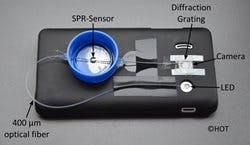Add-on photonics turn smartphone into biosensor for pregnancy tests and more
Researchers at the Hannover Centre for Optical Technologies (HOT), Leibniz University Hannover (Hannover, Germany) have developed a self-contained fiber-optic sensor for smartphones with the potential for use in a wide variety of biomolecular tests, including those for detecting pregnancy or monitoring diabetes.1 The readings of the sensor are processed by an app on the smartphone to provide real-time results.
When properly provisioned, the smartphone-user has the ability to monitor multiple types of body fluids, including: blood, urine, saliva, sweat or breath. In case of medical applications, the sensor readings can be combined with the GPS signal of a smartphone and users can then be guided to a drug store, hospital, or ambulance.
The fiber-optic surface-plasmon-resonance (SPR) sensor contains a 400-µm-diameter optical fiber with endfaces polished at 45° and an LED at one end as well as a diffraction grating at the other, placed in front of the phone's camera. A silver coating on a 10 mm length of polymer-coating-stripped fiber provides SPR when a fixed beam of light strikes the metallic film; most of the light is reflected, but a small band is absorbed by the film's surface electrons, causing them to resonate
When the metallic film is placed in contact with a fluid, the index of refraction of the liquid changes the absorbed band's size and location in the light spectrum. By adding recognition elements to the film that cause a shift in the index of refraction when bound to targeted biomolecules or trace gases, scientists can thus determine important information about a biological sample's composition based on which light is reflected and which is absorbed.
Sensitivity of 5.96x10−4 RIU
In a test with different volume concentrations of glycerol solution, a sensitivity of 5.96x10−4 refractive-index units (RIU)/pixel was obtained for a refractive-index (RI) range from 1.33 to 1.36.
"We have the potential to develop small and robust lab-on-a-chip devices for smartphones. So, surface-plasmon-resonance sensors could become ubiquitous now," said Kort Bremer, inventor and co-author of the new paper with Bernhard Roth, director of HOT.
REFERENCE:
1. Kort Bremer and Bernhard Roth, Optics Express (2015); doi: 10.1364/OE.23.017179
About the Author
John Wallace
Senior Technical Editor (1998-2022)
John Wallace was with Laser Focus World for nearly 25 years, retiring in late June 2022. He obtained a bachelor's degree in mechanical engineering and physics at Rutgers University and a master's in optical engineering at the University of Rochester. Before becoming an editor, John worked as an engineer at RCA, Exxon, Eastman Kodak, and GCA Corporation.

